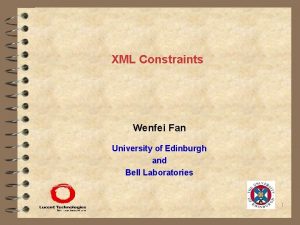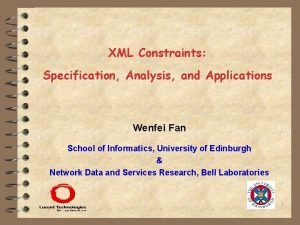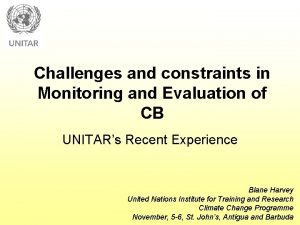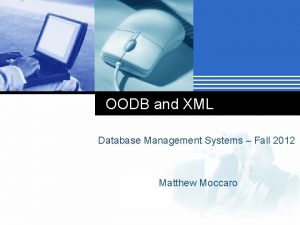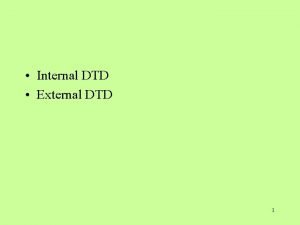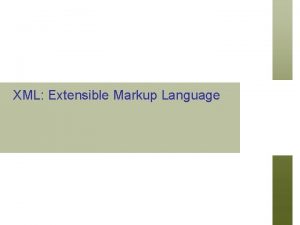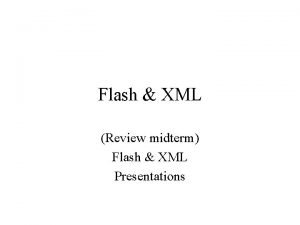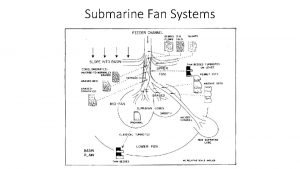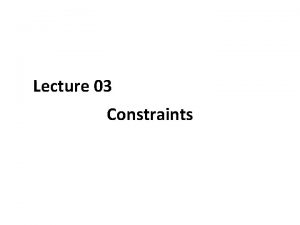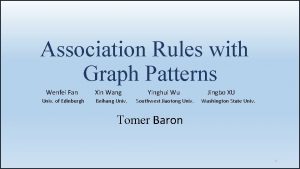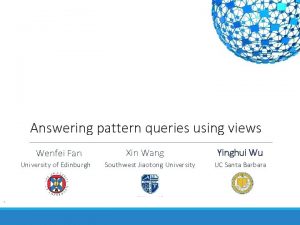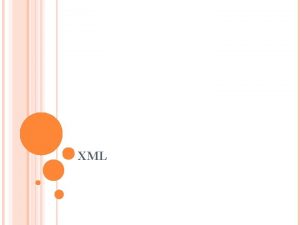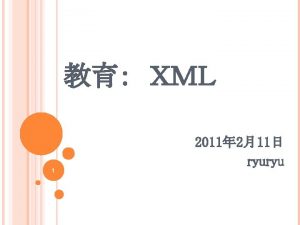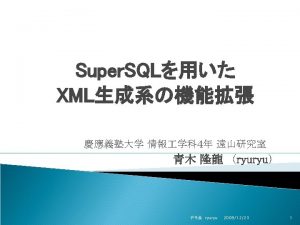XML Constraints Specification Analysis and Applications Wenfei Fan












![Absolute keys and foreign keys [PODS’ 00, 01] ü key: [X] . An XML Absolute keys and foreign keys [PODS’ 00, 01] ü key: [X] . An XML](https://slidetodoc.com/presentation_image/a6edf2de1746854b0429fe9e28f72957/image-13.jpg)
![Relative constraints [WWW’ 01, PODS’ 02] An XML tree specifies countries, province capitals. ü Relative constraints [WWW’ 01, PODS’ 02] An XML tree specifies countries, province capitals. ü](https://slidetodoc.com/presentation_image/a6edf2de1746854b0429fe9e28f72957/image-14.jpg)

![Relative keys and foreign keys ü key: ( 1[X] 1). An document satisfies the Relative keys and foreign keys ü key: ( 1[X] 1). An document satisfies the](https://slidetodoc.com/presentation_image/a6edf2de1746854b0429fe9e28f72957/image-16.jpg)


![Absolute path constraints [WWW’ 01] Absolute key: (Q, {P 1, . . . , Absolute path constraints [WWW’ 01] Absolute key: (Q, {P 1, . . . ,](https://slidetodoc.com/presentation_image/a6edf2de1746854b0429fe9e28f72957/image-19.jpg)
![Relative path constraints [WWW’ 01] Relative key: (Q, K) ü path Q identifies a Relative path constraints [WWW’ 01] Relative key: (Q, K) ü path Q identifies a](https://slidetodoc.com/presentation_image/a6edf2de1746854b0429fe9e28f72957/image-20.jpg)








![Consistency analysis [PODS’ 01, 02] ü Trivial for relational databases: given any schema and Consistency analysis [PODS’ 01, 02] ü Trivial for relational databases: given any schema and](https://slidetodoc.com/presentation_image/a6edf2de1746854b0429fe9e28f72957/image-29.jpg)


![Implication analysis [PODS’ 00, 01, 02, DBPL’ 01] Given D: a DTD : a Implication analysis [PODS’ 00, 01, 02, DBPL’ 01] Given D: a DTD : a](https://slidetodoc.com/presentation_image/a6edf2de1746854b0429fe9e28f72957/image-32.jpg)






![Constraint Propagation [ICDE’ 03] ü Input: – a set K of XML keys (context Constraint Propagation [ICDE’ 03] ü Input: – a set K of XML keys (context](https://slidetodoc.com/presentation_image/a6edf2de1746854b0429fe9e28f72957/image-39.jpg)





![Schema-directed integration [SIGMOD’ 03] DTD DB DB DB integratio n multiple, distributed sources constraints Schema-directed integration [SIGMOD’ 03] DTD DB DB DB integratio n multiple, distributed sources constraints](https://slidetodoc.com/presentation_image/a6edf2de1746854b0429fe9e28f72957/image-45.jpg)





- Slides: 50

XML Constraints: Specification, Analysis, and Applications Wenfei Fan School of Informatics, University of Edinburgh & Network Data and Services Research, Bell Laboratories 1

Outline ü XML Specifications: types and integrity constraints ü Specification of XML constraints: – keys, foreign keys, FDs – absolute vs. relative constraints ü Analysis of XML constraints – Consistency analysis – Implication analysis ü Applications of XML constraints, and research issues – Relational storage of XML data via constraint propagation – Schema-directed XML integration – Normal forms, query optimization, updates, data cleaning. . . 2

Introduction to XML specificaiton ü XML Specification: – types – integrity constraints – the need for XML constraints 3

XML data - an example Rooted, node-labeled tree – elements: db, province, capital, city, subtree/sub-document elements/subelements, e. g. , the capital child of province – @attributes: @name, @in. Province, carrying text – text nodes, e. g. , “Hasselt” db province @name city province . . . capital “Limburg” capital “Hasselt” @in. Province “Limburg” “others” @in. Province “Hasselt” “Limburg” 4

XML specification: DTD (type) ü Production: constrains the subelement list of each element <!ELEMENT db (province+, capital+)> province (city*, capital)> ü Attributes: uniquely identified by name for each element, unordered province: @name, capital: @in. Province db province @name city province . . . capital “Limburg” capital “Hasselt” @in. Province “Limburg” “others” @in. Province “Hasselt” “Limburg” 5

XML specification: integrity constraints Keys and foreign keys (vs. relational constraints): ü key: the value of a @name uniquely identifies a province. @name province capital. @in. Province capital ü FK: @in. Province of a capital references @name of a province capital. @in. Province province. @name db province @name city province . . . capital “Limburg” “others” @in. Province “Hasselt” “Limburg” capital “Hasselt” @in. Province “Limburg” 6

XML specification ü A type (DTD) D ü A set of integrity constraints, Example: ü DTD D: structure of the document, vs. types in a PL <!ELEMENT db (province+, capital+)> <!ELEMENT province (city*, capital)> province. @name, capital. @in. Province ü Constraints : defined in terms of data values across elements province. @name province capital. @in. Province province. @name 7

Why XML constraints? Supported by W 3 C XML standard, XML Schema In databases (supported by SQL standard), constraints are: ü an essential part of the semantics of data, ü fundamental to conceptual design, ü useful for choosing efficient storage and access methods, ü central to update anomaly prevention, … In the XML setting: constraints have proved useful in ü database storage of XML data (via constraint propagation), ü schema-directed database publishing/integration in XML, ü XML query optimization and formulation, ü design theory for XML specifications: normal forms ü data cleaning, … 8

Data exchange on the Web: XML publishing Web DTD XML constraints XML Q: XML view DB 1 DB 2 All members of a community (or industry) agree on a schema and exchange data w. r. t. the schema: e-commerce, health-care, . . . Schema-Directed XML Publishing/Integration: ü mapping data from traditional database to XML ü satisfying the predefined DTD and constraints 9

Data exchange on the Web: XML shredding Web XML keys XML shredding DB 1 propagation DB 2 relational FDs XML shredding: ü mapping XML data to relations ü relational design: normalization via constraint propagation from XML to relations – optimal relational storage of XML data – semantic connection: query/update optimization 10

XML constraints ü Specification of XML constraints: – keys, foreign keys, FDs – absolute vs. relative constraints 11

absolute constraints Absolute keys and foreign keys are to hold on the entire document. province. @name province capital. @in. Province province. @name Extensions of relational counterparts db province @name city province . . . capital “Limburg” capital “Hasselt” @in. Province “Limburg” “others” @in. Province “Hasselt” “Limburg” 12
![Absolute keys and foreign keys PODS 00 01 ü key X An XML Absolute keys and foreign keys [PODS’ 00, 01] ü key: [X] . An XML](https://slidetodoc.com/presentation_image/a6edf2de1746854b0429fe9e28f72957/image-13.jpg)
Absolute keys and foreign keys [PODS’ 00, 01] ü key: [X] . An XML document satisfies the key iff x y ext( ) ( l X (x. l = y. l) x = y) ü foreign key (FK): a combination of an inclusion constraint 1[X] 2[Y], and a key 2[Y] 2. A document satisfies the FK iff it satisfies the key and x ext( 1 ) y ext( 2 ) (x[X] = y[Y]) – , 1 , 2: element types; X, Y: sets (lists) of attributes; – ext( ): the set of elements in an XML document. Equality issue: ü (string) value equality: when comparing attributes ü node identify: when comparing XML elements Unary keys and foreign keys: defined in terms of single-attribute. 13
![Relative constraints WWW 01 PODS 02 An XML tree specifies countries province capitals ü Relative constraints [WWW’ 01, PODS’ 02] An XML tree specifies countries, province capitals. ü](https://slidetodoc.com/presentation_image/a6edf2de1746854b0429fe9e28f72957/image-14.jpg)
Relative constraints [WWW’ 01, PODS’ 02] An XML tree specifies countries, province capitals. ü What is a key for a province? ü What does @in. Province of a capital reference? db . . . country province . . . capital country province @name “Belgium” @name “Limburg” capital “Hasselt”@in. Province “Hasselt” “Limburg” @name capital “Limburg” . . . capital @name “Holland” “Maastricht” @in. Province “Limburg” @in. Province “Hasselt” “Limburg” 14

Examples of relative constraints Relative constraints: on a subdocument rooted at a country: key: country (province. @name province) country (capital. @in. Province capital) FK: country (capital. @in. Province province. @name) Absolute: on the entire document: country. @name country db . . . country province . . . capital @name country province “Belgium” . . . capital @name “Holland” capital “Hasselt” @in. Province @name capital “Maastricht” @in. Province “Limburg” @in. Province “Hasselt” “Limburg” @in. Province “Limburg” “Hasselt” 15
![Relative keys and foreign keys ü key 1X 1 An document satisfies the Relative keys and foreign keys ü key: ( 1[X] 1). An document satisfies the](https://slidetodoc.com/presentation_image/a6edf2de1746854b0429fe9e28f72957/image-16.jpg)
Relative keys and foreign keys ü key: ( 1[X] 1). An document satisfies the key iff c ext( ) y, z ext( 1) ( (y c) (z c) l X (y. l = z. l) y = z) ü foreign key (FK): ( 1[X] 2[Y] ) and a key ( 2[Y] 2). A document satisfies the FK iff it satisfies the key and c ext( ) y ext( 1) (( y c) z ext( 2 ) ((z c) y[X] = z[Y] )) where ü (y c): y is a descendant of c (y in the subtree rooted at c); ü : context type; ü ext( ): the set of elements in an XML document. 16

Relative vs. Absolute ü Absolute constraints are a special case of relative ones: country. @name country db ( country. @name country ) absolute: a fixed context type -- the root type r ü Absolute constraints are scoped within the entire document; whereas relative ones within the context of a subdocument. country (province. @name province) country (capital. @in. Province capital) country (capital. @in. Province province. @name) country. @name country Together they specify constraints on the entire document ü Beyond relational constraints; important for hierarchically structured data: XML, scientific databases, biomedical data, . . . 17

Define keys with path expressions ü XML data is hierarchically structured! “name” as a key for employees of companies only: target set is identified with a path expression: //company//employee ü XML data is semistructured: it may not have a DTD/schema! – key paths may be missing or have multiple occurrences key specification should be independent of types db company dept name company employee name government . . . university employee name @id @id name 18 first. Name last. Name
![Absolute path constraints WWW 01 Absolute key Q P 1 Absolute path constraints [WWW’ 01] Absolute key: (Q, {P 1, . . . ,](https://slidetodoc.com/presentation_image/a6edf2de1746854b0429fe9e28f72957/image-19.jpg)
Absolute path constraints [WWW’ 01] Absolute key: (Q, {P 1, . . . , Pk} ) ü Path expressions Q, Pi: XPath, regular path expressions, … ü target path Q: to identify a target set [[Q]] of nodes on which the key is defined (vs. relation) ü a set of key paths {P 1, . . . , Pk}: to provide an identification for nodes in [[Q]] (vs. key attributes) ü semantics: for any two nodes in [[Q]], if they have all the key paths and agree on them by value equality (existential), then they must be the same node (value equality and node identity) Examples: (//company//employees, {name, phone}) -- composite key ( //company//employees, {//@id}) -- multiple keys (//. , {@id}) -- capturing ID attributes in DTDs 19
![Relative path constraints WWW 01 Relative key Q K ü path Q identifies a Relative path constraints [WWW’ 01] Relative key: (Q, K) ü path Q identifies a](https://slidetodoc.com/presentation_image/a6edf2de1746854b0429fe9e28f72957/image-20.jpg)
Relative path constraints [WWW’ 01] Relative key: (Q, K) ü path Q identifies a set [[Q]] of nodes, called the context path; ü K = (Q’, {P 1, . . . , Pk} ) is a key on sub-documents rooted at nodes in [[Q]] (relative to Q). Example. (//country, (province, {@capital})) (//country, {@name}) -- absolute key ü Absolute keys are a special case of relative keys: (Q, K) when Q is the empty path ü Similarly foreign keys Specification of XML constraints is more involved than its relational counterparts 20

Keys and foreign keys in XML Schema key: (Q, {P 1, . . . , Pk} ) ü Path expressions Q, Pi: fragments of XPath ü Uniqueness and existence: for each node x in [[Q]] and each i in [1, n], there exists a unique node yi reached via Pi, and yi is either a text node or an attribute Foreign keys: (Q, ü (S, {P 1, . . . , Pk} ) (S, {S 1, . . . , Sk} ) is a key ü Uniqueness and existence: both Pi and Si The uniqueness and existence condition complicates the consistency and implication analyses Absolute constraint 21

Other constraints for XML Functional dependencies: {P 1, . . . , Pk} {S 1, . . . , Sk} ü Generalizations of relational FDs – for deriving an extension of relational-schema normal forms ü Absolute constraints [Arenas and Libkin, PODS’ 02] XIGs: x 1 … xn ( B(x 1, …, Xn) ∨ (i [1, l]) ( y 1 … yk Ci (x 1, …, xn, y 1, …, yk)) ü Generalization of relational embedded constraints ü B, Ci: conjunction of simple XPath expressions ü Subsuming relative keys and foreign keys (Deutsch and Tannen, [KRDB’ 01]) 22

Constraint analysis ü Analysis of XML constraints – Consistency analysis – Implication analysis – Absolute, relative, path-expression constraints 23

Consistency of XML specifications Given D: a DTD : a set of integrity constraints over D Consistency: Is there an XML document that both conforms to D and satisfies ? One wants to know whether XML specifications make sense! Run-time check: attempts to validate documents with (D, ). This would not tell us whether repeated failures are due to a bad specification or problems with the documents static analysis is desirable 24

An inconsistent specification The specification with D and is inconsistent! ü DTD D: <!ELEMENT db (province+, capital+)> <!ELEMENT province (city*, capital)> province. @name, capital. @in. Province ü Constraints : province. @name province capital. @in. Province province. @name In contrast, one can specify keys and foreign keys in SQL without worrying about their consistency with schema. 25

Cardinality constraints by keys, foreign keys Constraints : province. @name province capital. @in. Province province. @name Notation: ü ext( ): the set of elements in an XML document ü ext(. l): the set of l attribute values of all elements |ext(province. @name)| = |ext(province)| |ext(capital. @in. Province)| = |ext(capital)| |ext(capital. @in. Province)| |ext(province. @name)| |ext(capital)| |ext(province)| 26

Cardinality constraints imposed by DTDs DTD D: <!ELEMENT db (province+, capital+)> <!ELEMENT province (city*, capital)> Variables: ü Xprovince: the number of province elements under the root ü Xcapital: the number of capital subelements of the root ü Ycapital: the number of capital subelements of province’s Xprovince 1, Xcapital 1 |ext(province)| = Xprovince, Xprovince = Ycapital |ext(capital)| = Xcapital + Ycapital |ext(capital)| > |ext(province)| 27

The interaction Contradiction: ü From the constraints : |ext(capital)| |ext(province)| ü From the DTD D: |ext(province)| |ext(capital)| > Thus there exists NO XML document that both conforms to D and satisfies . db province @name city province . . . capital “Limburg” capital “Hasselt” @in. Province “Limburg” “others” @in. Province “Hasselt” “Limburg” 28
![Consistency analysis PODS 01 02 ü Trivial for relational databases given any schema and Consistency analysis [PODS’ 01, 02] ü Trivial for relational databases: given any schema and](https://slidetodoc.com/presentation_image/a6edf2de1746854b0429fe9e28f72957/image-29.jpg)
Consistency analysis [PODS’ 01, 02] ü Trivial for relational databases: given any schema and keys, foreign keys, one can always find a nonempty instance of the schema satisfying the constraints. ü Hard for XML: XML specifications may not be consistent! – Both DTDs and constraints impose cardinality constraints – The interaction between these two classes of cardinality constraints is rather complicated. 29

Consistency analysis of XML constraints Theorem: The consistency problem is ü undecidable for multi-attribute absolute keys and foreign keys; ü NP-complete for unary absolute keys and foreign keys, even for primary keys (primary: at most one key for each element type); ü in NEXPTIME for primary multi-attribute absolute keys and unary foreign keys ü in NEXPTIME and PSPACE-hard for unary absolute regular keys and foreign keys (target path: / , where is a regular path expression and an element type; key paths: attributes) ü undecidable for relative keys and foreign keys, even when all the constraints are unary and primary. As opposed to the trivial analysis of the relational counterpart. 30

Some tractable cases ü Restrictions on constraints. Theorem: For multi-attribute relative keys only, the consistency problem is in linear time for arbitrary DTDs. Recall relative keys: country (province. @name province) In contrast, due to the existence and uniqueness condition: Theorem: It is intractable for unary keys alone in XML Schema. ü Restrictions on DTDs: Theorem: When DTD is fixed, the consistency problem is in PTIME for absolute unary keys and foreign keys. In practice, DTD is designed at one time, but constraints are written in stages: constraints are incrementally added. 31
![Implication analysis PODS 00 01 02 DBPL 01 Given D a DTD a Implication analysis [PODS’ 00, 01, 02, DBPL’ 01] Given D: a DTD : a](https://slidetodoc.com/presentation_image/a6edf2de1746854b0429fe9e28f72957/image-32.jpg)
Implication analysis [PODS’ 00, 01, 02, DBPL’ 01] Given D: a DTD : a set of constraints expressed in C : a property (a constraint of C) Implication (C ): Is it the case that for any XML document, if it conforms to D and satisfies , then it must satisfy ? C: a constraint language The need for studying implication: ü data integration: constraints checking at virtual views ü optimization of XML queries and XML relational storage ü design theory for XML specifications: normalization 32

Some complexity results for implication analysis Theorem: The implication problem is ü undecidable for multi-attribute absolute keys and foreign keys, and for unary relative keys and foreign keys; ü PSPACE-hard for unary regular absolute keys and foreign keys; ü co. NP-complete for unary absolute keys and foreign keys. ü co. NP-hard for XML-Schema unary keys ü in linear time for absolute multi-attribute keys; ü in PTIME for arbitrary absolute keys and foreign keys when the DTD is fixed, and ü in PTIME for relative path keys in the absence of DTDs The analysis of XML constraints is far more intricate than its relational counterpart 33

Applications ü Application of XML constraints, and open problems – Constraint propagation – Schema-directed XML integration – Normal form – Query rewriting/optimization – Update processing – Data cleaning –. . . 34

XML shredding: relational storage of XML data Web XML keys XML shredding DB 1 propagation DB 2 relational FDs XML shredding: ü mapping XML data to relations ü relational design: normalization – optimal relational storage of XML data – semantic connection: query/update optimization 35

Example: XML constraints ü (//book, {isbn}) -- isbn is an (absolute) key of book ü (//book, (chapter, {number}) -- number is a key of chapter relative to book ü (//book, (title, { })) -- each book has a unique title db book isbn “XML” “ 1” title book chapter number section number text title DTD number section “ 6” number book isbn chapter “XML” number title “ 1” XPath 36 “ 10”

Mapping from XML to a predefined relation Predefined RDB: chapter(book. Title, chapter. Num, chapter. Title) ü Mapping: for each book, extract its title, and the numbers and titles of all its chapters ü Predefined relational key: (book. Title, chapter. Num) Can the XML data be mapped to the RDB without violating the key? db book isbn “XML” “ 1” title book chapter number section number text title DTD number section “ 6” number book isbn title chapter “XML” number title number 37 “ 1” XPath “ 10”

A safe mapping Now change the relational schema to RDB: chapter(isbn, chapter. Num, chapter. Title) The relation can be populated without any violation. Why? The relational key (isbn, chapter. Num) for chapter is implied (entailed) by the keys on the original XML data: (//book, {isbn}), (//book, (chapter, {number}), (//book, (title, { })) db book isbn “XML” “ 1” title book chapter number section number text title DTD number section “ 6” number book isbn title chapter “XML” number title number 38 “ 1” XPath “ 10”
![Constraint Propagation ICDE 03 ü Input a set K of XML keys context Constraint Propagation [ICDE’ 03] ü Input: – a set K of XML keys (context](https://slidetodoc.com/presentation_image/a6edf2de1746854b0429fe9e28f72957/image-39.jpg)
Constraint Propagation [ICDE’ 03] ü Input: – a set K of XML keys (context and target path: a fragment of XPath, key paths: attributes) – a predefined relational schema S, – a mapping f from XML to S (XPath, projection, join, union) – and a relational functional dependency FD over S ü Output: is the FD propagated from K via f? I. e. , does FD hold over the DB f(T) for any XML document T that satisfies K? Theorem: The constraint propagation problem is in PTIME. ü Checking the consistency of a predefined relational schema for storing XML data ü XML schema/DTD is not required – K is the only semantics 39

Deriving relational schema for storing XML One wants to find a “good” relational schema to store: chapter(isbn, book. Title, author, chapter. Num, chapter. Title) What is a good schema? In normal form: BCNF, 3 NF, … ü Prevent update anomaly (the relational theory) ü Efficient storage, query optimization … But how to find a normalized design? db book isbn “XML” “ 1” title book chapter number section number text title DTD number section “ 6” number book isbn title chapter “XML” number title number 40 “ 1” XPath “ 10”

Constraint propagation and normalization From the given XML keys: (//book, {isbn}), (//book, (chapter, {number}), (//book, (title, { })) one can derive functional dependencies: isbn book. Title, isbn, chapter. Num chapter. Title Normalize the relation by using these functional dependencies: chapter(isbn, book. Title, author, chapter. Num, chapter. Title) book(isbn, book. Title), chapter(isbn, chapter. Num, chapter. Title), author(isbn, author) The new schema is in BCNF! 41

Computing minimum cover of propagated FDs ü Input: a set K of XML keys, and a mapping f from XML to a universal schema U ü Output: a minimum cover F of all the functional dependencies (FDs) propagated from the XML keys K via f – F is a cover (a set of FDs): any FD propagated from K via f is implied by F – F is minimum: F contains no redundant FDs, i. e. , any FD in F is not entailed by other FDs in F. Theorem: There is a PTIME algorithm for computing a minimum cover of propagated FDs. Normalize relational schema for storing/querying XML data! 42

Research issues For general constraints/mapping languages: undecidable ü if the mapping language is relationally complete (selection, projection, join, union, difference), even for XML keys alone ü if both XML keys and foreign keys are considered, even for the identity “transformation” Open: ü To identify (a) practical mapping languages and (b) practical XML constraints that allow efficient constraint propagation ü Constraint propagation from relations to XML – Information preserving (lossless) data exchange – Query/update rewriting/optimization – Overcoming incompleteness of source data (foreign keys) 43

XML publishing/integration Web DTD XML constraints XML Q: XML view DB 1 DB 2 All members of a community (or industry) agree on a schema and exchange data w. r. t. the schema: e-commerce, health-care, . . . Schema-directed XML Publishing/Integration: ü mapping data from traditional database to XML ü satisfying the predefined DTD and constraints 44
![Schemadirected integration SIGMOD 03 DTD DB DB DB integratio n multiple distributed sources constraints Schema-directed integration [SIGMOD’ 03] DTD DB DB DB integratio n multiple, distributed sources constraints](https://slidetodoc.com/presentation_image/a6edf2de1746854b0429fe9e28f72957/image-45.jpg)
Schema-directed integration [SIGMOD’ 03] DTD DB DB DB integratio n multiple, distributed sources constraints XML view üSchema-directed: XML view conforming to a schema (D, ) – D: a DTD – : a set of XML constraints (relative keys, foreign keys) ü Attribute Integration Grammar (AIG) � DTD-directed view definition: recursive, nondeterministic Inherited and synthesized attributes � Constraint compilation: automatically captures integrity constraints and DTD in a uniform framework 45

XML normal forms ü Extensions of (nested) relational normal forms, via XML FDs – M. Arenas and L. Libkin. A Normal Form for XML Documents, [PODS 02]. XNFs, decomposition algorithms, complexity, … – M. Vincent, J. Liu and C. Liu. Strong functional dependencies and their application to normal forms in XML. [TODS 29(3), 2004] – X. Wu, T. W. Ling, S. Lee, M. Lee, G. Dobbie. NF-SS: A Normal Form for Semistructured Schema. [ER (Workshops) 2001] ü Research issues – Implication analysis: more intriguing than relational FDs – Relative functional dependencies: hierarchical nature of XML – “Right” normal form: XML data is typically stored in RDBMS • redundancy often helps, e. g. , performance and reliability • XML data is often “static”: update anomalies? 46

Run-time analysis: incremental constraint checking Input: XML tree T, constraints , update ∆T, where T satisfies Question: does (T + ∆T) satisfy ? ü ∆X. Code generator: incremental checking. Lucent applications M. Benedikt, G. Brun, J. Gibson, R. Kuss and A. Ng. Automated update management for XML integrity constraints. [PLANX’ 02] ü Application of incremental techniques for attribute grammar M. Abrao, B. Bouchou, M. Alves, D. Laurent, M. Musicante. Incremental Constraint Checking for XML Documents [XSym’ 04] Research issues: ü Complexity of incremental constraint checking ü XML editors: broken link detection and repair ü Incremental checking techniques for XML data stored in RDBMS 47

Query rewriting and optimization Query translation from XQuery to SQL: XML data stored in RDBMS – encode XIGs and XQuery in relational queries and constraints – extensions of chase and backchase A. Deustch and V. Tannen – Reformulation of XML Queries and Constraints [ICDT’ 03] – MARS: A System for Publishing XML from Mixed and Redundant Storage [VLDB’ 03] R. Krishnamurthy, R. Kaushik, J. Naughton. Efficient XML-to-SQL Query Translation: Where to Add the Intelligence? [VLDB 2004] Research issues: ü Rewriting queries over (recursive security) views of XML data ü Query optimization for (compressed) XML data in native store 48

Data cleaning Input: XML tree T, constraints , DTD D Question: if T does not satisfy D + , find a repair T’ such that (a) T’ satisfies D + , and (b) the distance between T and T’ is minimal (update operations: insert, delete, modify) ü G. Flesca, F. Furfaro, S. Greco, E. Zumpano. Repairs and Consistent Answers for XML Data with Functional Dependencies [XSym’ 03] Research issues: ü Effective techniques for repairing integrated XML data: conflicts and inconsistencies may emerge as violations of constraints. – Various constraint languages, – XML schema ü Automated tools for repairing Web pages: broken links 49

Summary ü Specification of XML constraints: – absolute vs. relative, path constraints: XML data is hierarchical and semi-structured – mild extensions of relational constraints are not sufficient ü Consistency and implication analysis of XML constraints – DTDs interact with XML constraints – far more intricate than their relational counterparts ü Applications of XML constraints – XML storage, query, update, integration, cleaning, … – many practical issues remain to be explored 50
 Wenfei fan
Wenfei fan Wenfei fan
Wenfei fan Wenfei fan
Wenfei fan Propagation delay in cmos
Propagation delay in cmos Deu nexia fan sensornexia fan sensor
Deu nexia fan sensornexia fan sensor Wenfei wu
Wenfei wu Specifications and constraints
Specifications and constraints If lclp is negative number, we set the lclp = 0. why?
If lclp is negative number, we set the lclp = 0. why? Limites de control
Limites de control Microsoft xml paper specification essentials pack
Microsoft xml paper specification essentials pack Xml web service
Xml web service Tercet meaning
Tercet meaning Software requirement analysis and specification
Software requirement analysis and specification Marriages and families changes choices and constraints
Marriages and families changes choices and constraints Marriages and families changes choices and constraints
Marriages and families changes choices and constraints Job redesign meaning
Job redesign meaning Job analysis for personal specification
Job analysis for personal specification Petri nets properties analysis and applications
Petri nets properties analysis and applications The resistance r experienced by a partially submerged body
The resistance r experienced by a partially submerged body Petri nets properties analysis and applications
Petri nets properties analysis and applications Travelers among mountains and streams
Travelers among mountains and streams Plug and play fan
Plug and play fan Cpu fan and heatsink mounting points
Cpu fan and heatsink mounting points What decisions are involved in channel management
What decisions are involved in channel management Scleronomic meaning in tamil
Scleronomic meaning in tamil Constraints and statical determinacy
Constraints and statical determinacy Shortest path linear programming
Shortest path linear programming Difference constraints and shortest paths
Difference constraints and shortest paths Cost benefit constraint example
Cost benefit constraint example Challenges in monitoring and evaluation
Challenges in monitoring and evaluation Criteria and constraints clipart
Criteria and constraints clipart Constraints and statical determinacy
Constraints and statical determinacy Synchronous manufacturing and theory of constraints
Synchronous manufacturing and theory of constraints Cengage
Cengage Oodb and xml database
Oodb and xml database Internal dtd
Internal dtd Sgml vs html
Sgml vs html Asynchronous javascript and xml
Asynchronous javascript and xml Asynchronous javascript and xml
Asynchronous javascript and xml Data integration with xml and semantic web technologies
Data integration with xml and semantic web technologies And xml
And xml And xml
And xml History of html
History of html Slidetodoc.com
Slidetodoc.com Ygfc
Ygfc Submarine fan
Submarine fan Compound fan truss
Compound fan truss Aberration
Aberration Dunyoning yetti mo'jizasi 4-sinf
Dunyoning yetti mo'jizasi 4-sinf Psixodramma metodi
Psixodramma metodi Umumiy pedagogika tarixi
Umumiy pedagogika tarixi

